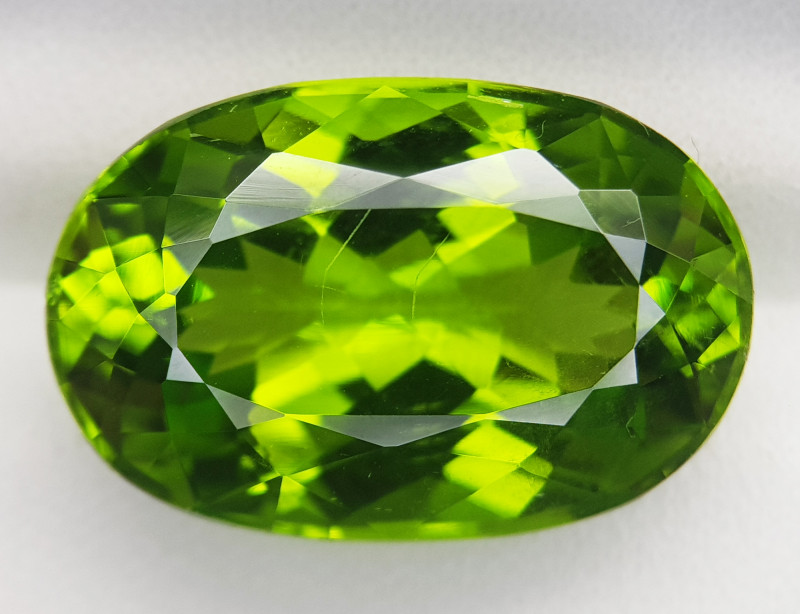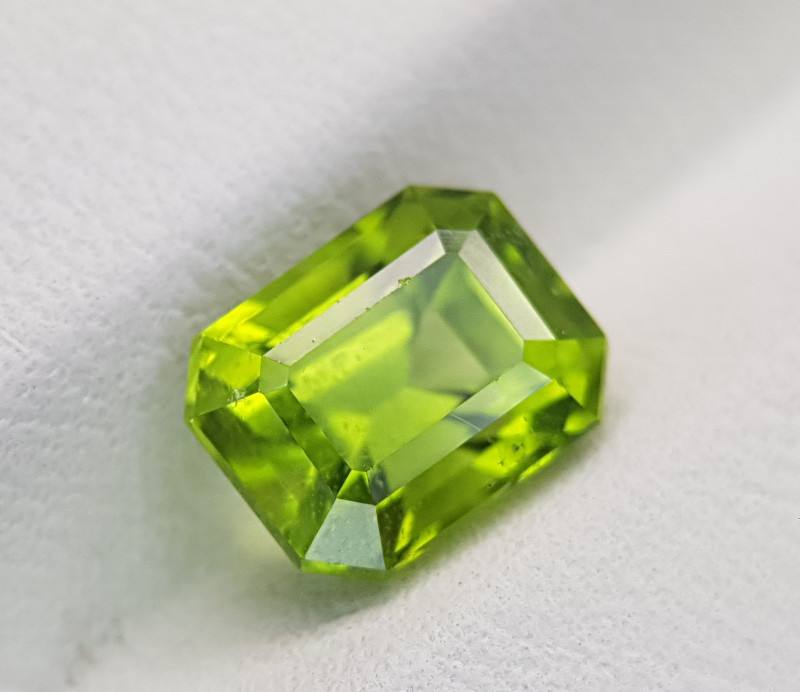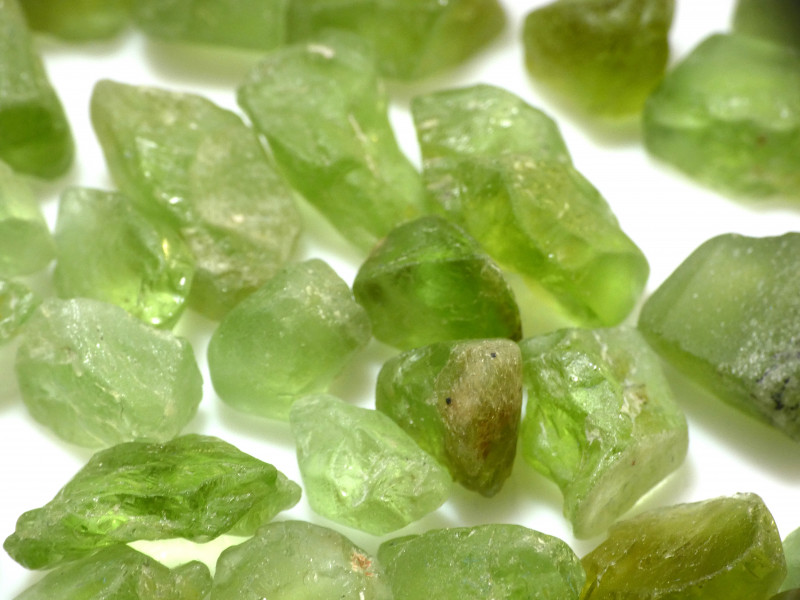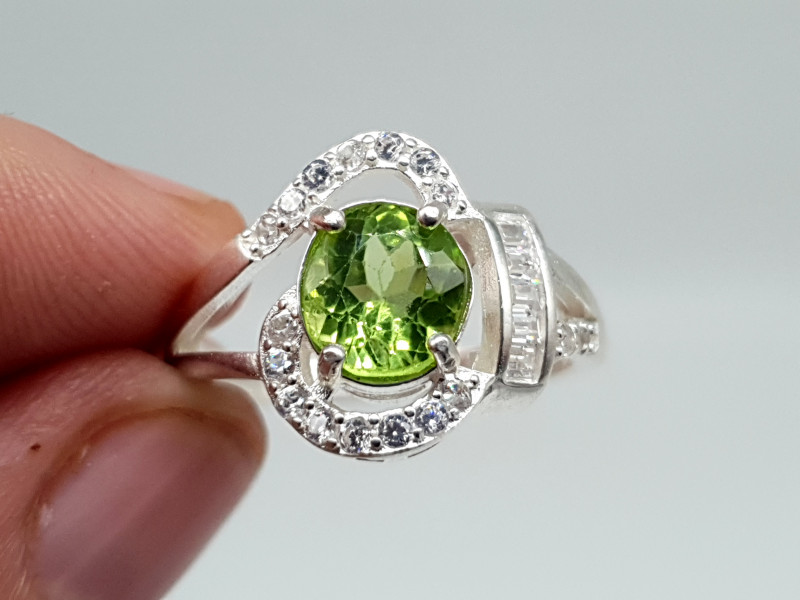Olivine Gemstone: Properties, Meanings, Value & More
 Olivine gemstones are brittle, rock-forming minerals typically found in dark-colored igneous rocks at the earth’s surface and some meteorites. Some scientists even suggest that the moon’s mantle contains olivine! It is a silicate mineral group containing different proportions of magnesium, iron, and other elements.
Olivine gemstones are brittle, rock-forming minerals typically found in dark-colored igneous rocks at the earth’s surface and some meteorites. Some scientists even suggest that the moon’s mantle contains olivine! It is a silicate mineral group containing different proportions of magnesium, iron, and other elements.
Where did olivine get its name? Just look at its color! Olivine is named for its typically varying shades of yellow and olive green.
Curious to know more about this intergalactic gem? Lucky for you, Gem Rock Auctions is your trusted source for all things gemstones. We’ve put together a complete run-down on olivine’s, uses, value, spiritual benefits, and more.
Keep reading to learn all there is to know about olivine!

About Olivine Gemstones
Olivine (ol-uh-veen) is an abundant silicate found inside the earth’s mantle. Many meteorites also contain olivine, making it one of the first gems to exist outside of our solar system!
The color of olivine is typically yellowish-green, but can also contain vivid yellows, greens, oranges, and browns. It has a brittle, fractured texture and varies in opacity from translucent to transparent.
What is an olivine crystal? Olivine is widely known as the mineral variety of peridot (pair-uh-doe), a popular green gemstone. Also called chrysolite, it’s one of the only gemstones defined by its yellowish, olive-green hue.
So is olivine a precious gem? While olivine is abundant in the earth, peridot is quite rare, making it a rare and precious gem!
In 1912, peridot was coined the official birthstone for August. It is also a milestone gem for the 16th wedding anniversary, in which the olivine gemstone’s meaning is one of unwavering love and admiration.
Wait — does that mean that olivine is the same as peridot? Yes and no!
Olivine vs. Peridot
If you’re wondering what the difference is between olivine and peridot, it’s nothing major. While many in the gem industry refer to the two interchangeably, olivine refers to the mineral class, whereas peridot is the actual gem variety of olivine.

Olivine Specifications & Characteristics
Olivine is a group of silicate minerals composed of forsterite, fayalite, monticellite, and tephroite. They typically appear in dense, fractured masses with rounded grains and glass-like luster. While olivine is one of the most common minerals in the earth by volume, large specimens of gem-quality peridot are hard to come by.
Here’s an overview of olivine’s mineral data:
Hardness: 6.5-7
Color: Olive-green, light green, dark green, yellow-green, yellow-brown, and brown. Rarely white, gray, or orange.
Crystal structure: Orthorhombic
Luster: Vitreous
Transparency: Transparent to translucent
Refractive index: 1.635 - 1.690
Specific Gravity: 3.22 - 3.45
Cleavage: Poor/Indistinct
Fracture: Conchoidal
Olivine’s Streak: Colorless
Pleochroism: Weak; Yellow-green, green, and colorless

Types of Olivine Gemstones
As we mentioned earlier, olivine refers to a group of magnesium iron silicate minerals. Though it’s not officially classified as an individual mineral species by the International Mineralogical Association (IMA), it’s recognized as a mineral series with forsterite and fayalite end members. Most olivine varieties would fall somewhere in between.
Varieties of the olivine mineral group are:
Chrysolite - refers to a yellow or yellow-green form of olivine; is synonymous with olivine or peridot.
Peridot - transparent, olive-green gemstone variety of olivine with several different styles.
Dunite - solid, grainy masses of olivine; typically classified as a rock.
Olivinoid - an extraterrestrial form of olivine found in many meteorites.

Olivine Meaning & History
Olivine has a pretty long recorded history! Ancient text suggests that olivine gemstones were mined as early as 1500 B.C. In those times, Egypt was the go-to source for peridot, or “Gem of the Sun” It was believed to help ward off evil spirits. Ancient priests would adorn cups with peridot for communion with their Nature Gods, and Pharaohs would often use it in their talismans. Historians suggest that Cleopatra even wore olivine stone jewelry regularly!
Peridot in its Hebrew name, “pitdah.”. is also referenced many times in the Christian Bible. At that time, it was believed to contain the power of nature. The Book of Exodus describes a Jewish High Priest’s breastplate containing one stone for each of the twelves Israelian tribes — one being peridot. The Bible also describes the impressive olivine crystal jewelry worn by King Ezekial of Exodus.
Peridot is woven into Hawaii’s ancient folklore, too! Its beautiful green hue is reminiscent of the tropics and is believed to symbolize the tears of the goddess of volcanoes and fire, Goddess Pele. It’s pretty fitting when you recall that peridot is formed by volcanic activity — but more on that later!
Today the Smithsonian Museum of Natural History in Washington, D.C., houses the largest peridot in the world. It weighs 311.8 carats (62.35 grams) and is believed to have originated from Zabargad Island (now St. John's Island) in Egypt.
So now that you know how olivine gemstones got their start way back when, let’s dive into what olivine is used for today!

Olivine Healing Properties
So what does olivine stone mean today? Each gemstone has unique characteristics that allow them to be used as healing stones. They can aid in the balance and health of your spiritual, emotional, and physical body. Olivine is no exception — it can help boost your health, soothe negative emotions, realign your chakras, and attract good vibes into your space.
Physical Healing
In the olden days, powdered peridot was used as a medical remedy to treat asthma and excessive thirst in feverish patients. While it isn’t suspected to be toxic if ingested, its oral medicinal use has been mostly retired today. However, olivine gemstones can still offer up their share of noteworthy physical healing!
Olivine is thought to act as a powerful sterilizer that helps release toxins at all levels. Crystal healers use it to strengthen the immune system, support metabolism, and boost skin health. Proponents suggest it may also help treat ulcers, strengthen the eyes, balance symptoms of bipolar disorders, and relieve symptoms of hypochondria.
Emotional Healing
Feeling green with envy? Some of the emotional olivine crystal benefits include alleviating resentment, jealousy, spite, and bitterness. It is also believed to help ward off feelings of anxiety and irritation.
Its calming effects are also known to help you fall asleep. By placing peridot under a pillow or near your bed, it helps ease the mind from worrying or overthinking so you can blissfully slip into a peaceful slumber.
…but what does olivine crystal do spiritually?

Chakra Healing
While some chakra stones balance all the chakras, peridot holds vibrations aligned to the solar plexus and heart chakras. Crystal healers use olivine gemstones to open, activate, and clear these chakras during balancing and natural healings.
How do you know if these chakras aren’t in alignment? A blocked heart chakra will manifest itself in feelings of fear, discontent, or even disease. A blocked solar plexus can cause you to feel anxious and unable to feel joy or bliss.
Olivine is used in jewelry intended to be worn close to these chakras. This helps open them up to the free-flowing energy of healthy Chi and provides the positive vibrations they need to stay open and healthy.
Spiritual Healing / Balancing Energy
Similar to the way it realigns your chakras, peridot can help shift the energy in your space. In Feng Shui, green symbolizes the color of wealth and abundance. Its yellowish-green hues are also strongly associated with sunlight and nature. When placed in certain areas of the home, it is believed to invite certain energies into your space.
So, where should you keep your olivine gemstones?
Xun Area: This area, or “gua” as it is referred to in Feng Shui, is associated with wealth, prosperity, and financial abundance. What many forget is that it’s also associated with self-worth, generosity, and spiritual abundance. Activate Xun by placing peridot in this area — typically located in the back, left corner of your home.
Zhen Area: Located in the middle, left section of your home, this gua is associated with family and new beginnings. Placing a green gem, like peridot, in this area can promote harmony and support for a fresh start.

Olivine Gemstone Properties
Peridot is often confused with other green gemstones such as apatites, emeralds, garnets, moldavites, and zircons. Remember when we said Cleopatra wore olivine on the daily? Many of the emeralds that Cleopatra was believed to have worn were, in fact, peridots — legend says they were her favorite gem!
Here’s what to look for in your olivine gems:
Color
As the name suggests, olivine is typically an olive-green color. It can sometimes appear with shades of yellow, orange, and brown. Pure green peridot gemstones are rare, with most of them appearing yellowish green. Lower-quality peridot will appear more brown.
Cut
Olivine gemstones are cut in many ways ranging from traditional, faceted cuts to creative fantasy cuts to tumbled beads and peridot cabochons. Since it isn’t a pricey gem, lapidaries focus more on beauty than carat weight.
Clarity
The Gemological Institute of America (GIA) classifies peridot as a Type-2 colored gemstone clarity grade. In other words, eye-clean clarity is typically the standard. Genuine peridot will have some inclusions and internal fractures, especially larger stones. The fewer inclusions, the higher the value. Perfectly clean peridot is usually an indication that it’s fake.

Carat Weight
Olivine gemstones vary in sizes from melee to faceted stones of 10 cts. or more. Fine faceted stones of 300 carats or more exist but are rare.
Treatments
There aren’t any known treatments to improve the color or clarity of peridot. Therefore, it’s not heat-treated or enhanced in any way. There have been instances of shady producers using metal-foiling to increase stability or coat paler stones.
How To Determine If Olivine is Real
The key to identifying real peridot is their high birefringence (or double refraction), lack of cleavage, alteration, and of course, its notable shades of olive green. Its green luster also doesn’t change, regardless of light.
The best way to tell if peridot is real is by examining the stone’s color under different types of light — artificial, bright, dim, and so forth. Only real peridot will remain a shimmery green throughout.

Olivine Formation & Sources
So where is olivine found? Unlike most gems that are formed in the earth’s crust, peridot (and diamonds) are formed much deeper in the earth’s mantle!
Most olivine gemstones are located within tectonic plates and divergent plate boundaries deep inside the surface of the earth. Its high temperature of crystallization makes it one of the first minerals to crystallize from magma.
As magma cools, olivine crystals form and accumulate at the base of the magma chamber. Tectonic activity then brings the peridot to the surface. There aren’t any other gems that form in lava flows 25 miles under the Earth's surface — making peridot super rare and unique!
Mining Locations
Want to mine for olivine?
While peridot got its start in Egypt’s Red Sea, they haven’t produced any for decades. Fortunately, it can be found in many places worldwide today — including the United States!
American peridot mines are located in Arkansas, Arizona, Nevada, and Hawaii. The San Carlos Apache Indian Reservation is also home to some olivine gemstones, however, they’re rarely bigger than 10-carats.
For larger sizes, Pyaung Gaung in Burma’s Mogok Stone Tract is unrivaled, frequently boasting gem discoveries of 10-carats and more. Other foreign sources include Australia, Kenya, China, Brazil, Myanmar, Pakistan, South Africa, Tanzania, Norway, and Sri Lanka.
If you’d rather skip the mining and purchase peridot that’s already been cut, you’re going to want to prep your budget. Let’s look at what the price of olivine is and how its value is determined.

Olivine Price & Value
So are olivine crystals valuable? While they’re relatively inexpensive in comparison to other precious gems, their value depends on factors like color, cut, and carat.
Well-cut peridot gems will range from $50 to $80 per carat. The price increases from there based on color and weight. With a general range of $50 to over $500 — olivine gemstones are fairly accessible for most budgets.
Olivine Care and Maintenance
So you finally snagged some olivine, but how do you clean it?
When caring for your gemstones, you want to remember that it isn’t a standard, universal process for every gem. While peridots are pretty durable, they aren’t indestructible. They can scratch, chip, or shatter if you aren’t careful.
Luckily, olivine gems are pretty easy to clean. Warm, soapy water works best. Wash the gem gently and let it air dry. Avoid ultrasonic or steam cleaners. Their high vibrations and temperatures could damage your stone.
Store olivine gemstones in a cool, dry place away from anything that might scratch or hit it. Avoid exposure to heat, acid, or sudden temperature changes.

Focus On the Good with Olivine!
While the popularity of the olivine gemstone has been inconsistent over the years, its recent resurgence is shining new light on this precious, celestial gem. Not only does it look absolutely beautiful while costing less than other gems, but it literally attracts positive vibes! Who wouldn’t want a little more of that?
Ready to rock the same jewels as the iconic Cleopatra? Shop for olivine today!
Was this article helpful?
Ross Sedawie
- Written - 5th Mar 2022
- Edited - 6th Jan 2024

















